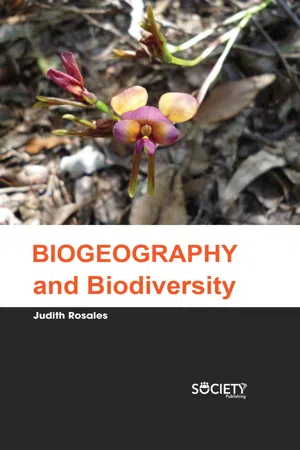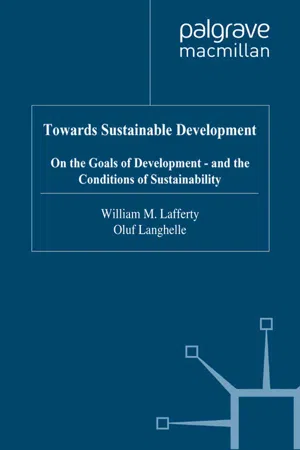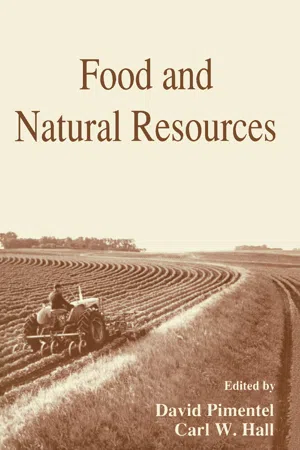Geography
Biological Resources
Biological resources refer to the living organisms and materials derived from them that are utilized by humans for various purposes, such as food, medicine, and raw materials. These resources include plants, animals, microorganisms, and genetic material, and are essential for sustaining life and supporting human activities. They are a key focus in geography due to their significance in shaping ecosystems, economies, and human societies.
Written by Perlego with AI-assistance
Related key terms
1 of 5
5 Key excerpts on "Biological Resources"
- eBook - PDF
- Judith Rosales(Author)
- 2019(Publication Date)
- Society Publishing(Publisher)
Biodiversity or biological diversity embrace the whole of “Life on Earth.” It describes the variety and also the variability of all the living organisms in a given framework. If there is any sort of decline in biodiversity, then the changes occurred are directly or indirectly related to the reduction and simplification of biological heterogeneity, from individuals to various regions. Basically, Biological Resources are those important resources of biodiversity, which helps in maintaining and organizing the necessities of human beings in a systematic Economic Significance of Biodiversity 137 manner. This is considered as the anthropocentric view of Biological Resources, which offers a flexible and transparent way to analyze alternative value paradigms in context to economic factors. For many environmental economists’ intrinsic values are more appropriate for taking decisions related to the conservation of resources, but these intrinsic value of biodiversity is difficult to measure. All the services rendered by the ecosystem like, agriculture, forestry and fisheries products, stable natural hydrological cycles, fertile soils, a balanced climate are dependent on practices taken up for the conservation of biological diversity. Production of food is dependent on biodiversity for a variety of food plants, pollination, nutrient provisions, disease prevention and control, and so forth. Both medicinal plants and manufactured pharmaceuticals rely on biodiversity. When there is a decline in biodiversity, it leads to an increment in the transmission of diseases to humans, thus increasing the healthcare costs of an individual. Also, the outdoor tourism industry relies on biodiversity to create and maintain the records of all visitors and what is the contribution of tourism industry in growth of fishing and hunting industry. 5.2 SECTORS CONTRIBUTING TOWARDS THE ECONOMY OF A COUNTRY There are many sectors that contribute towards the economy of a nation by using natural resources. - eBook - PDF
Towards Sustainable Development
On the Goals of Development - and the Conditions of Sustainability
- Oluf Langhelle, W. Lafferty(Authors)
- 1999(Publication Date)
- Palgrave Macmillan(Publisher)
If so, management perspectives on natural resources would come more in line with ecological understanding- an understanding which has been reached through considerable research in the area, both basic and applied. This under- standing has clearly taught us that there are greater threats against nature than just pollution and over-exploitation. Finally, I will try to put the ecological discussion in the context ofthe book's major theme - sustainable development. Sustainable development is first and foremost connected with social-political problems (as earlier emphasised in Stenseth and Hertzberg, 1992). However, one main condition for attaining sus- tainable development is that the Earth's biological diversity is not emaciated, leading to several of the central ecological problems. An introduction to the rel- evant specialised ecological approaches to the problem is, therefore, import- ant. 6.2 THE EARTH'S BIOLOGICAL DIVERSITY From a biological- or 'biogeographical'- standpoint, the world is often divided into those different regions where plant and animal life have several common features, not least in their development. These are called biogeographical regions. We have six such regions in total: the palearctic (including the Nordic countries); the nearctic (encompassing North America); the neotropic (South and Central America); the afrotropic (the African continent, except for the northern parts of Africa, which very much resemble the palearctic region and thus arc classified as the same region); the oriental (encompassing the Far East); and the australasiatic (mainly Australia, New Zealand and some of the surrounding islands). These regions are different both with respect to the types and the number of species they sustain. One thing is indisputable: most of the Earth's biological diversity is found in the Third World. For example, Kloppenburg (1988) estimates that three- quarters of all species are found in the Third World. - eBook - PDF
- Preethi Kartan(Author)
- 2019(Publication Date)
- Delve Publishing(Publisher)
In ancient times, people who utilized this so-called “bounty of nature”, survived sustainably and carefully. People who misused or sometimes overused it disintegrated. Science and technology have made an effort to categorize and classify the diversity in nature for over a hundred years. This has then led to a basic understanding of its association into different communities of plants as well as animals. This kind of information usually aids in using the biological wealth available on earth for the profit or benefit of humanity. Also, this has been a fundamental principle for development. This basically comprises better crops, better health care and also the utilization of different life forms as raw materials for the growth of industries that has led to a greater standard of living for the advanced world. On the other hand, this has also developed the new consumerist society, which basically has had a negative or bad effect on the variety of Biological Resources on which it is based. The diversity or variety of life on earth is very huge that if it is used sustainably, various useful products can be developed for various generations from biodiversity. This can happen only when biodiversity is managed as a valuable resource and ultimately this prevents the species extinction. Biodiversity or biological diversity is that portion of nature that consists of the dissimilarities in genes amongst the individuals of a specific species, the richness and variety of all species of plant and animal at distinct scales in space, in region, in the country and in the world, various other kinds of An Introduction to Biodiversity 3 ecosystems both aquatic and terrestrial, within a specified area. Biological diversity basically deals with the level of variety of nature in the biosphere. - eBook - PDF
Geography of Tourism
Image, Impacts and Issues
- Peter Mason(Author)
- 2017(Publication Date)
- Goodfellow Publishers(Publisher)
3 Geographical Resources for Tourism Introduction Chapters 1 and 2 made brief reference to a number of potential geographical resources for tourism. Some of these resources are located within the physical environment, such as landscapes, and include coastal area, moorlands and mountains. Others are part of the human environment, including towns and cities and historic monuments – in summary this is usually known as the built environment. These physical resources and human resources are not necessarily located separately but are often found together. For example, a coastal tourism destination has a physical environment which may be made up of a beach, a shoreline, the sea and it could be backed by cliffs. This will be coupled with a human environment of, for example, hotels, restaurants and bars and possibly, a harbour or marina. This chapter considers the physical and human resources for tourism. Key perspectives Approximately 50 years ago, Peters (1969) provided an attempt to classify tourist attractions. His classification, which was made in relation to international tour-ism, had five categories, which are as follows: Cultural: (e.g. sites of archaeological interest, historical buildings and muse-ums, political institutions) Traditions: (e.g. festivals, music, folklore, arts and handicrafts) Scenic: (e.g. National Parks, wildlife, flora and fauna, beach resorts, moun-tain resorts) Entertainment: (e.g. zoos and aquaria night life, cinema, theatre, theme parks) Other attractions: (e.g. climate, health resorts, spas, unique attractions not available elsewhere) (source: Peters,1989) Not long after Peters put forward his fivefold classification, Robinson (1976) argued that very many tourism attractions are, in fact, geographical and suggested that Geography of Tourism 28 there are seven geographical aspects of tourism. - eBook - PDF
- David Pimentel(Author)
- 2012(Publication Date)
- Academic Press(Publisher)
Each year various soil organisms break down and degrade about 20 t of organic matter per hectare (Alexander, 1977). This degradation is essential for the release of bound nutrients and their sub-sequent recycling for further use in the ecosystem (Golley, 1983). Some soil biota help control pests in crops, and others fix atmospheric ni-trogen for use by plants (Pimentel et al., 1980b). Earthworms, insects, and other biota open holes, improve water percolation, and loosen the soil to enhance new soil formation. Because the complex roles of these biota are not clearly understood, great care should be taken to prevent the extinction of any species. VII. LOOKING TO THE FUTURE The earth contains resources of land, water, energy, and natural biota, which are needed and used by humans for their survival. All these re-sources are interrelated and the availability of one influences the quality, quantity, and usefulness of another. Thus, fossil energy can be used to increase production on land, but supplies of both land and energy can be stressed in the process. The growing human population, with its needs for food and fuel, is using up important environmental resources, many of which are finite and cannot be resupplied. Population pressures in some parts of the world already are well above the capacity of resources to provide all people living there with a prosperous standard of living (Keyfitz, 1976), and out-right shortages of basic resources now exist in some places (Ehrlich et al., 1977; CEQ, 1980). Soon, if not at present, the people of the world will have to decide whether they want a relatively prosperous life style with ample supplies of food, water, and energy for a population of one to two billion or whether they will be satisfied with limited resources and a meager existence because they allowed the world population to grow to ten times this number.
Index pages curate the most relevant extracts from our library of academic textbooks. They’ve been created using an in-house natural language model (NLM), each adding context and meaning to key research topics.




